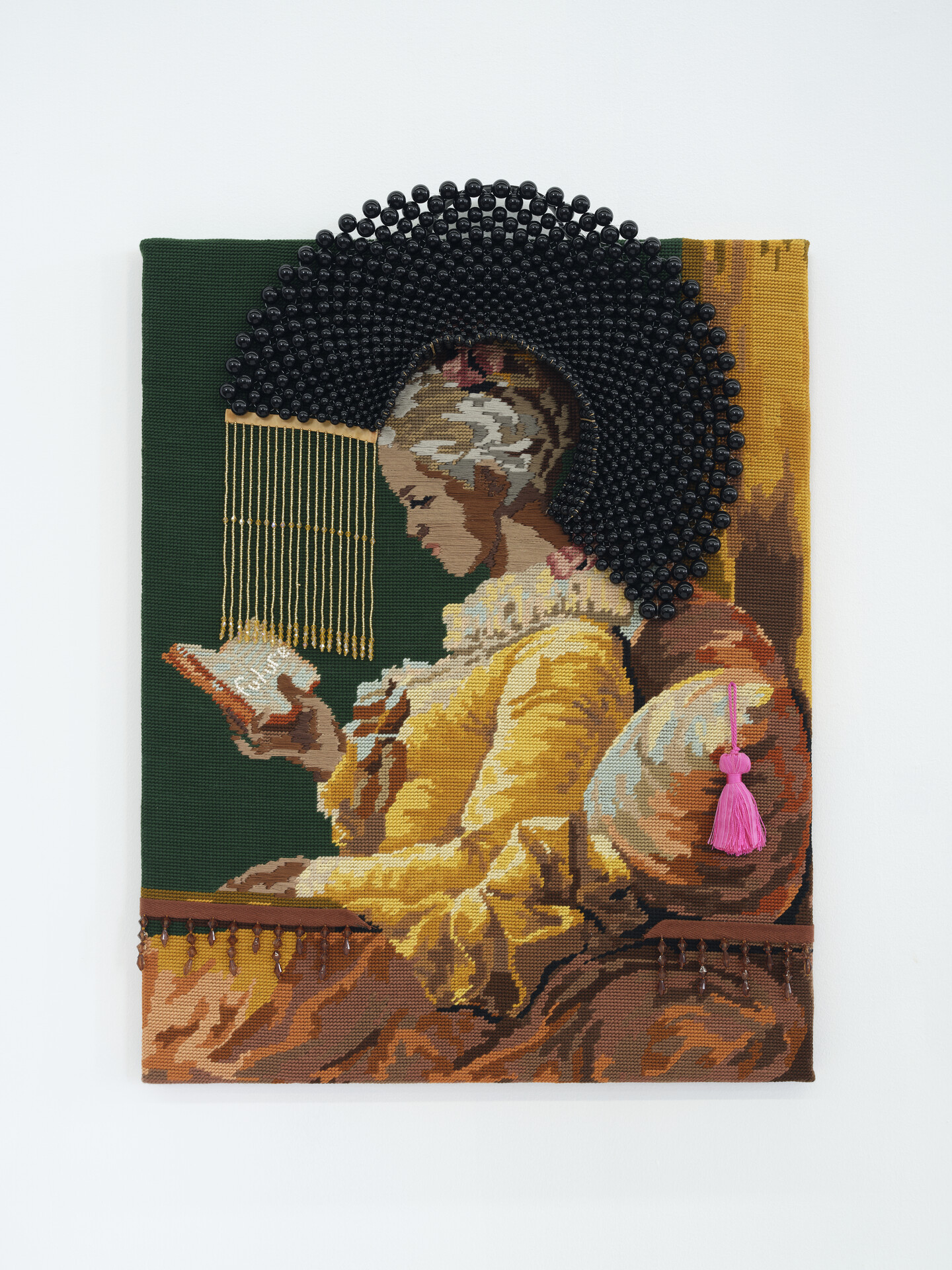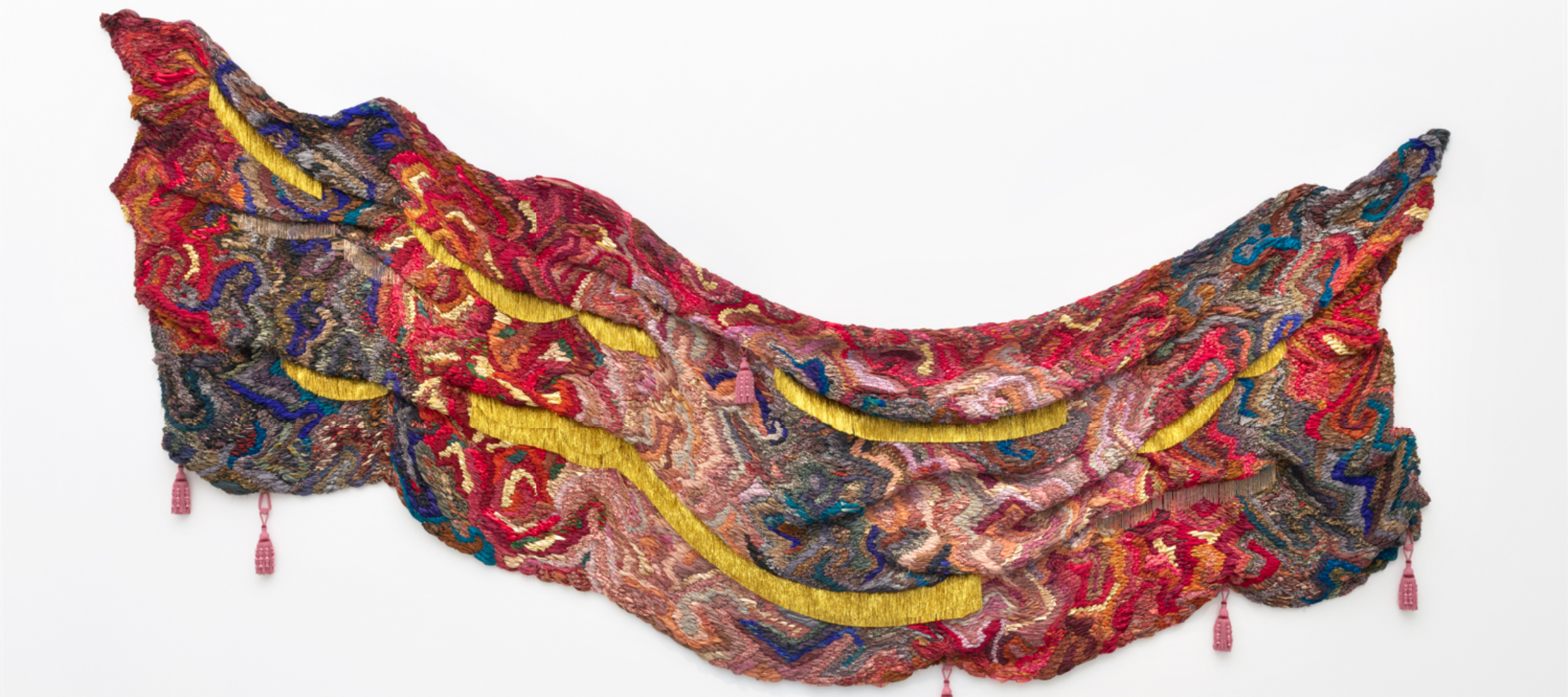WASHINGTON—The National Museum of Women in the Arts (NMWA) presents a solo exhibition of work by acclaimed multidisciplinary artist Suchitra Mattai (b. 1973). On view from September 20, 2024, through January 12, 2025, Suchitra Mattai: Myth from Matter will feature approximately 40 mixed-media works and large-scale textile installations that explore how memory, myth and visual culture can counter colonial and patriarchal narratives. The exhibition marks the Los Angeles-based artist’s first major solo museum exhibition on the East Coast and coincides with three other solo presentations taking place across the country. A fully illustrated catalogue will accompany the exhibition.
Combining richly colored saris, vintage needlepoints, book pages, jewelry, tinsel, bindis, beads and other found objects, Mattai creates layered textile installations, sculptures, collages and paintings that re-envision Indo-Caribbean colonial history. Extending Mattai’s practice of incorporating materials and symbols from across disparate times and places, the exhibition will present the artist’s works alongside a selection of related historical objects from Europe and South Asia. The resulting juxtapositions initiate a visual conversation between old and new, East and West, and history and mythology.
“We are honored to show the extraordinary work of Suchitra Mattai this fall,” said NMWA Director Susan Fisher Sterling. “Her powerful tapestries provide rich narratives that speak to history, identity and migration.”
Interventions and Reinvention
Mattai’s work restores the presence of marginalized people into histories from which they have been excluded. Using a practice she calls “brown reclamation,” the artist sews brown thread over the faces and bodies of white Europeans who typically populate pastoral landscapes. In as we know it, as we dream it (2023), Mattai incorporated a found tapestry that depicts two women sitting beneath a tree, a third woman perched above on a rope swing, and a man who holds one end of the rope. Mattai darkened the figures’ skin and hair and added bright embroidery floss, floral appliqué and beads. Her disruption of the serene scene refocuses attention on those who were exploited and whose labor enabled this type of leisure. In this reinterpretation of history, the idealized colonial landscape becomes a space of recreation and respite for people of color, especially those of Caribbean and South Asian descent.

Mattai’s tapestries also call attention to the unrecognized work of women. Historically, textile work was not considered a “fine” art due to its association with women’s domestic practices. Mattai upends this outdated designation, transforming vintage tapestries into vivid scenes of celebration and joy. In future perfect (2023), she reimagines artist Jean Honoré Fragonard’s Young Girl Reading (ca. 1769). Continuing Fragonard’s well-documented practice of working and reworking his own paintings, Mattai makes interventions directly on a mass-produced needlepoint reproduction, adding a jeweled headdress and pink tassel to the scene, while also sewing over the figure’s skin with brown thread. Traditionally, embroidery was both an act of decoration and repair; in Mattai’s work, it redresses single-sided histories that have long sidelined women and omitted people of color.
Through cultural, familial and personal references, Mattai confronts systemic erasure on a scale that is both monumental and intimate. She creates new mythologies that reclaim colonial spaces, materials and histories—and center women and people of color. By subverting past narratives, Mattai manifests a more egalitarian future.
Weaving Histories
Many of Mattai’s works include saris that she has received from the women in her family, friends and even strangers. “I often use vintage saris as a way of connecting women of the South Asian diaspora from around the world,” she says. In The Center of Gravity (2022), the artist incorporates her own childhood sari with vintage fabrics and ghungroo bells, which are typically worn around the ankles of classical Indian dancers. The large-scale abstract tapestry a cosmic awakening (2023) interlaces jewel-toned saris with shimmery tinsel, beaded fringe and tassels. The work traverses time and geography, as Mattai joins varied artistic mediums that allude to several places and cultures.
“Combining, recontextualizing, and reconfiguring disparate materials is a way of making sense of the world around me and of reconciling multiple cultural spheres that I inhabit as an Indo-Caribbean woman,” says Mattai.
Global Diaspora
Mattai’s Indo-Caribbean identity inspires much of her practice and the specific iconography and materials that she uses. However, her deft application of these personal references echoes the wider experience of global diasporas. The artist’s family arrived in Guyana by way of India in the 19th century, when both countries were under British colonial occupation; her great-grandparents crossed the Atlantic as indentured laborers to work on sugar plantations. Guyana achieved independence from Britain in 1966, just seven years before Mattai’s birth, and her family later immigrated to Canada.
Mattai learned to sew and embroider from her grandmothers, and she honors her lineage by weaving inherited textiles and heirlooms into her fiber-based sculptures and installations. Her work is both intercultural and intergenerational, informed by her home country’s history and created through practices and materials passed down from her ancestors.
About Suchitra Mattai
Suchitra Mattai (born 1973, Georgetown, Guyana) received an MFA in painting and drawing and an MA in South Asian art from the University of Pennsylvania. Her work has been presented in group and solo exhibitions at the Museum of Contemporary Art Chicago; Institute of Contemporary Art Boston; Crystal Bridges Museum of American Art, Bentonville, Arkansas; Boise Art Museum, Idaho; Center for Visual Art at the Metropolitan State Museum of Denver; and the Sharjah Biennial, United Arab Emirates. Mattai’s work is included in collections such as the Crystal Bridges Museum of Art; Denver Art Museum; Tampa Museum of Art; Portland Museum of Art, Maine; Shah Garg Collection; and Jorge Pérez Collection. Mattai is a recipient of a Smithsonian Artist Research Fellowship. She lives and works in Los Angeles.
Press Preview
A press preview will be held on Monday, September 16 at 10 a.m. and feature a tour with Suchitra Mattai and remarks by curator Hannah Shambroom. Register here: https://forms.gle/h3sFuW8agQNHyfzT7.
Publication
NMWA will publish a fully illustrated catalogue for Suchitra Mattai: Myth from Matter. The volume features a lead essay by author and art critic Aruna D’Souza, a conversation with Mattai about her studio practice and imagery of the artist’s work alongside historical objects that illuminate her reference points from art and culture of the Indo-Caribbean diaspora.
In addition to Myth from Matter at NMWA, the artist has solo presentations of work at the Socrates Sculpture Park in Queens, New York (May 11–August 25, 2024), Institute of Contemporary Art San Francisco (June 5–September 15, 2024) and the Tampa Museum of Art (June 20, 2024–March 16, 2025).
Suchitra Mattai: Myth from Matter is organized by the National Museum of Women in the Arts. The exhibition is generously supported by Stephanie Sale and the members of NMWA.
National Museum of Women in the Arts
The National Museum of Women in the Arts (NMWA) is the first museum in the world solely dedicated to championing women through the arts. With its collections, exhibitions, programs and online content, the museum inspires dynamic exchanges about art and ideas. NMWA advocates for better representation of women artists and serves as a vital center for thought leadership, community engagement and social change. NMWA addresses the gender imbalance in the presentation of art by bringing to light important women artists of the past while promoting great women artists working today. The collection highlights a wide range of works in a variety of mediums by artists including Rosa Bonheur, Louise Bourgeois, Lalla Essaydi, Lavinia Fontana, Frida Kahlo, Hung Liu, Zanele Muholi, Faith Ringgold, Niki de Saint Phalle and Amy Sherald.
NMWA is located at 1250 New York Avenue, NW, Washington, D.C. It is open Tues.–Sun., 10 a.m.–5 p.m., until 8 p.m. on the third Wednesday of the month (June through August) and closed on Mondays and select holidays. Admission is $16 for adults, $13 for D.C. residents and visitors 70 and over, and free for visitors 21 and under. Admission is free the first Sunday and second Wednesday of each month. For information, call 202-783-5000, visit nmwa.org, Broad Strokes blog, Facebook or Instagram.
Media Contacts
National Museum of Women in the Arts
Amy Mannarino, amannarino@nmwa.org
Emma Filar, efilar@nmwa.org
Nicole Straus Public Relations
Katrina Weber Ashour, katrina@krwaconsulting.com
Amanda Domizio, amanda@domiziopr.com
